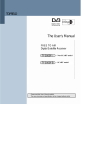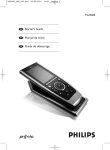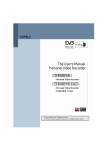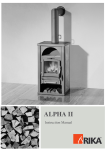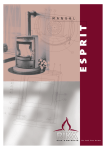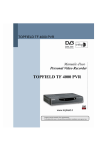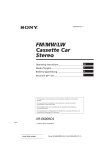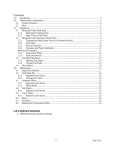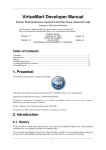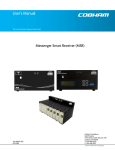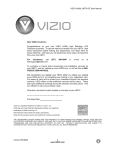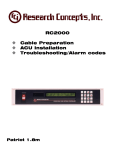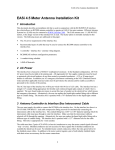Download Topfield TF3100FEI Satellite TV System User Manual
Transcript
TOPFIELD The User’s Manual FREE TO AIR Digital Satellite Receiver TF3100FEi TF3100FEP pro - Embedded Positioner Please read this User s Manual carefully. The menu structure and specification can be changed without notice. TABLE OF CONTENTS INTRODUCTION CONTENTS FEATURES FRONT/ REAR PANELS 1) FRONT PANEL 2) REAR PANEL 4 5 5 6 6 6 REMOTE CONTROL UNIT (RCU) GETTING STARTED FUNCTION GUIDE MENU OPERATIONS 1) SYSTEM SETTING 2) ORGANIZING CHANNEL 3) ORGANIZING FAVORITES 4) INSTALLATION * POSITIONER SETTING GUIDE(Positioner model only) 5) INFORMATION 6) GAME TROUBLE SHOOTING (Q & A) SPECIFICATIONS 8 14 15 17 18 28 30 31 38 50 52 54 55 CAUTION RISK ELECTRIC SHOCK Do NOT OPEN This symbol indicates “dangerous voltage” inside the product that presents a risk of electric shock or personal injury. This symbol indicates important instructions accompanying the product. CAUTION: TO REDUCE THE RISK OF FIRE OR ELECTRIC SHOCK, DO NOT EXPOSE THIS APPLIANCE TO RAIN OR MOISTURE Please do not insert metal or alien substance into the slots for the Modules and Cards. In doing so can cause damage to the STB and reduce its life span. WARNING Warning WARNING Warning WARNING Please read the following recommended safety precautions carefully for your safety. MAINS SUPPLY : 90-250V AC 50/60 Hz. OVERLOADING : Do not overload wall outlets, extension cords or adapters as these can result in fire or electrical shock. LIQUIDS : Keep liquids away from the STB. The apparatus shall not be exposed to dripping or splashing and that no objects filled with liquids, such as vases, shall be placed on the apparatus. SMALL OBJECTS : Coins or other small objects must be kept away from the IRD as they can fall through the ventilation slots of the IRD and cause serious damage. CLEANING : Disconnect the IRD from the wall socket before cleaning it. Use a dry cloth lightly dampened(no solvents) to clean the exterior of the IRD. VENTILATION : Do not block the decoder’s ventilation slots. Ensure that a free airflow is maintained around the IRD. NEVER stand the IRD on soft furnishings or carpets. Do not use or store the IRD where it is exposed to direct sunlight or near a heater. NEVER stack other electronic equipment on top of the IRD. ATTACHMENTS : Do not use any attachments that are not recommended as these may cause hazards or damage the equipment . SERVICING : Do not attempt to service this product yourself. Refer all serving to qualified service agents. LIGHTNING : It is recommended that the IRD should remain connected at all times to the mains supply and satellite dish (except when working on the LNB). However, the manufacturer’s instructions for safeguarding other equipment connected to the IRD, i, e, TV set, must be followed during lightning storms. LNB and the modem telephone line are essential. EARTHING : The LNB cable must be earthed to the system earth for the satellite dish. LOCATION : Locate the IRD indoor place properly to prevent lightening, raining and direct sunlight. WARNI NG CONNECTION TO THE SATELLITE DISH LNB : Disconnect the IRD from the mains before connecting or disconnecting the cable from the satellite dish. FAILURE TO DO SO CAN DAMAGE THE LNB, INTRODUCTION Thank you for purchasing the Digital Satellite Receiver (STB). This Digital Satellite Receiver is fully compliant with the international DVB standard and thus transmits digital images, sounds, information guides and teletext directly to your TV through the satellite. Now you can comfortably see and receive digitally transmitted music, news, movie and sports satellite broadcasts in your office or at your home. In the Channel Search section, both the automatic channel search method and the manual Search mode are provided. Also it supports DiSEqC 1.2, enabling you to move your antenna in order to focus your preferred satellite. You can save up to 3500 TV and 1500 Radio channels and work around with the Favorite, Lock, Delete, Move and Sort functions. The Menu is very modern and supports different languages. All functions can be carried out using the remote control and some of the functions can also be carried out using the front panel. The STB is easy to use and adaptable for future advances. Please be aware that new software may change the functions of the STB. If you have any difficulties concerning the operation of your STB, please refer to the relevant section of this manual, including the ‘Troubleshooting’. This Manual will I NTRODUCTI ON provide you with useful information on using the STB. CONTENTS Please ensure that the following items are included with the STB. 1) Remote control unit 2) Batteries (size AAA) 3) User’s Guide (this document) FEATURES Fully Compliant to DVB Antenna/LNB control - 22KHz mode On/Off - 0/12V mode selection - Automatic FEC Detection - DiSEqC 1.0 & 1.2 compatible - Built-In Positioner (High Power Azimuth Control-36DC,5A) ....(Positioner model only) Satellite/Channel support - 3500 TV channels, 1500 Radio channels storable OSD (On Screen Display) support - 256 color support. - Multi-lingual menu text support. - GMT and Time Offset support - 10 favorite channel groups support - Page Up/Page Down available on your channel list - PIG ( Picture In Graphic ) support Teletext - Software emulation mode with always VBI insertion mode on. Games are embedded. CONTENTS / FEATURES Video/Audio - Automatic and Manual PAL/NTSC selection - Multi-lingual Audio support - Automatic channel search FRONT / REAR PANELS 1) Front Panel - STANDBY The power button of STB (ON / Stand by) - LED REMOTE STANDBY - CHANNEL The channel buttons are to change channels. 2) Rear Panel FRONT/REAR PANEL S (Non-Positioner model) FRONT / REAR PANELS Positioner model only (Embedded Positioner model) Connects the satellite antenna cable. LNB OUT Use it to connect to another STB. 0/12V OUTPUT Chooses the LNB on the antenna. RS232 Upgrades the STB Program & software. TV SCART Connects the TV SCART. VCR SCART Connects the VCR SCART. VIDEO OUTPUT Video output (YELLOW). AUDIO-LEFT INPUT Audio input (WHITE). AUDIO-RIGHT INPUT Audio input (RED). RF IN Connects the TV antenna. RF OUT Connects the TV. DISH CONTROL Connects the actuated dish. FRONT/REAR PANEL S LNB IN REMOTE CONTROL UNIT (RCU) Switches the STB between Operation and Standby mode. Enables/ Disables the Audio. Selects the TV or Radio service channels and individual menu options. Displays the Menu on screen or returns to previous menu from submenu. Displays the EPG (Electronic Progam Guide) on screen only when available. Adjusts the volume (Increase/Decrease). Tunes to the next or previous service. Services up or down through the available services. Displays Channel List on screen. Selects the item in the menu mode. REM OTE CONTROL UNI T Returns to the previous menu and the screen. Displays the program information box on the screen and removes it. Selects the previously viewed channel. REMOTE CONTROL UNIT (RCU) Selects the TV/Radio mode. Stills the playing picture. Changes the terrestrial TV and Satellite mode. Selects LEFT/RIGHT/MONO/STEREO sound function. Selects the subtitle language list for the current service. Enables the teletext with software emulation. Displays the favorite channel list. Selects function. (F1) Selects function. (F3) Selects function. (F4) REM OTE CONTROL UNI T Selects function. (F2) REMOTE CONTROL UNIT (RCU) Displays and alters the UHF setting in menu. REM OTE CONTROL UNI T Displays sleep time. When sleep time, the power automatically turns to the OFF mode and the STB to the STANDBY mode. INSTALLATION (Connection) First, connect both the satellite antenna and the TV line to the STB and switch the power on. In this manual there are some of the most common ways to connect the equipment: TV, VCR and STB. There are several ways of connecting the STB to the existing Audio/TV system. We recommend using one of the following setups. If you have problems with your connections and need help, contact your dealer or Service Provider. 1) Connection to TV, VCR and Hi-Fi 1-1) Connection to the TV with the SCART Cable. Connect one end of the SCART cable to the TV SCART socket on the STB and the other end to a SCART socket on the TV. Connect one end of the SCART cable to the VCR SCART socket on the STB and the other end to a SCART socket on the VCR. I NSTAL L ATI ON 1-2) Connection to the VCR with the SCART Cable. INSTALLATION (Connection) 1-3) Connection to the TV with the CINCH Cable. Connect one end (3 connectors) of the CINCH cable to the AUDIO-RIGHT (red), AUDIO-LEFT (white) and the VIDEO OUTPUT (yellow) socket on the STB. Connect the other end (3 connectors) to the AUDIO-RIGHT input (red), AUDIO-LEFT input (white) and the VIDEO input (yellow) socket on the TV or Hi-Fi. 1-4) Connection to the TV using the RF cable. Connect a terrestrial antenna to RF IN socket on the STB. Connect one end of the RF cable to the RF OUT socket on the STB. Connect the other end to the ANT IN socket on the TV. I NSTAL L ATI ON 2) Connection to the other Satellite Receiver. Connect the satellite cable to the LNB IN socket on the STB. With a connector, connect the LNB OUT socket on the STB and the ANT IN socket of the other STB. INSTALLATION (Connection) Positioner model only 3. Connection to the dish. (Positioner model only) 3-1) Connection to an actuated dish Connect the LNB IN socket of the STB to the LNB. Connect motor wires to M1 and M2. Switch these connections if the motor moves to the wrong direction. Connect sensor wires to PULSE and GND connector. Connect a mechanical polarotor to +5V, GND and SKEW connectors. Improper connetion cause malfunction or may break down your STB and Motor 3-2) Connection to an actuated dish with C/Ku switch . I NSTAL L ATI ON Connect the cables from C and ku-band LNB to 12 Volt C/Ku switch. Connect the coaxial cable from the 0/12 Volt switch to LNB IN connector. Connect the power cable which comes from the 0/12 Volt switch to the 0/12V connector. Connect motor wires to M1 and M2. Switch these connections if the motor moves to the wrong direction. Connect sensor wires to PULSE and GND connectors. Connect a mechanical polarotor to +5V,GND and SKEW connectors. GETTING STARTED Press the Power button to operate the STB from the STANDBY mode. Now, the Info box will appear for a given time and disappear. Pressing the INFO button, the Info box will remain on the screen. The display time of the Info box is adjustable under the I n s t a l l a t i o n Menu of the M a i n Menu. If the current broadcast has EPG (Electronic Program Guide) with it, press the GUIDE button to see not only the current channel’s but also other channel’s EPG without any time constraints. Also, press the button to reserve and save the current service and to watch the broadcast automatically when it starts. IMPORTANT: Before taking charge of your new STB, some important technical settings are essential. - Adjust your antenna through Dish Setting menu in installation menu. - First, press the MENU button on the RCU to make the M a i n Menu appear. - Go to the L N B S e t t i n g menu under the C h a n n e l S e a r c h item of the I n s t a l l a t i o n menu and press button. - The Default PIN CODE is 0 0 0 0. - Choose the right parameters for Satellite Name, LNB Frequency, 22KHz, 12 V, DiSEqC 1.0, and Motorized System according to your LNB and satellite settings. If the right Satellite Name and LNB Frequency were not found in the list, call the dealer for satellite information. - Then, press the MENU button and go back to the C h a n n e l S e a r c h menu. - Set the S e a r c h M o d e to the A u t o mode. (A M a n u a l or A d v a n c e d S e a r c h can always be performed later on) - Select the S t a r t S e a r c h . . . item and press GETTI NG STARTED - The search procedure will take a while. Press the button. button when the searching process is over (100%) to confirm and save the new channel list. - For further information, please refer to the L N B S e t t i n g item of the MENU OPERATIONS on this manual. Function Guide Information Box Press INFO key on the RCU to see the program information. The Information box displays as follows: Channel Number Channel Name Detailed Program Information Signal Level & Quality Satellite Information Information of subtitle and / or teletext EPG (Electronic Program Guide) schedules. The button makes the reservation for the next program. button shows extended information of the current program. button will change the contents of EPG between TV and Radio services. FUNCTI ON GUI DE To use currently showing TV, and Radio services as well as to use next program schedules, press button on the remote control unit. If EPG is available on programs, you will see the detailed description of the programs, start/end time and programs schedules etc. , and , buttons will be used to move program and to see next program Function Guide Subtitle You can choose a language of subtitle using button on the RCU. If a broadcaster provides subtitles, you can see symbol in the Information Box. Teletext If a broadcaster supports teletext, you can see symbol in the Information Box. There are VBI insertion mode and software emulation mode in teletext. In the VBI insertion mode, which is always on, you can watch the teletext with your TV using the RCU of your TV. To watch teletext with VBI insertion, your TV must support teletext. In the software emulation mode, you can watch the teletext even though your TV does not support teletext. You can watch the teletext using the RCU of STB. Press button twice to watch the teletext with software emulation mode. Press button or EXIT button to escape from teletext. Soundtrack FUNCTI ON GUI DE S ound Track AUTO Track 01 Track 02 Track 03 Track 04 Track 05 Track 06 Track 07 Track 08 S ound Mod e Mono You can choose a language of soundtrack using button on the RCU when a broadcaster supports various languages of soundtrack. Also, it is possible to choose a mode among S t e r e o, M o n o, L e f t and R i g h t using the , buttons on the RCU. MENU OPERATIONS Now this chapter assumes that the STB system has been installed correctly, meaning: * The satellite dish for the STB has been installed, connected to the STB and correctly adjusted to the proper satellite. * The STB is connected to the TV. * The RCU has batteries and ready to control the STB. If the STB has not been installed or connected properly, please refer to the I N S T A L L A T I O N (connection) menu on this manual. M ENU OPERATI ONS Many of the functions of the STB are available from the M a i n Menu. Press the MENU button to open it. MENU OPERATIONS I. SYSTEM SETTING I-1 TIME SETTING Various time modes can be set, such as the current local time, the Power On/Off time and the Sleep Time. The exact local present time can be adjusted by using the G M T, the T i m e O f f s e t and the M o d e sub menus. M ENU OPERATI ONS PLEASE NOTE: Configure the L o c a l T i m e before adjusting the W a k e u p T i m e,P o w e r O f f T i m e or the S l e e p T i m e. MENU OPERATIONS A. Local Time Setting Press the button at L o c a l T i m e S e t t i n g item in the T i m e S e t t i n g Menu to open the L o c a l T i m e S e t t i n g menu. Inside the L o c a l T i m e S e t t i n g menu, there are 4 sub menus: M o d e, L o c a l T i m e,G M T and T i m e O f f s e t. Local Time The L o c a l T i m e is adjustable only when the M o d e is on the M a n u a l mode. Adjust the current time, if necessary, by using the numeric buttons and the , buttons. GMT GMT is referred to the standard time of Greenwich. This cannot be changed. M ENU OPERATI ONS Mode Bysing the , buttons, you can control the A u t o/M a n u a l mode. The A u t o mode automatically updates the time settings by adding the GMT received from the satellite and the T i m e O f f s e t value you have inserted. The A u t o mode is recommended. MENU OPERATIONS Time Offset The current time of the local area can be inserted. In another words, insert the time difference of the local time zone from the GMT. For example, if the local area is Seoul (the time difference from the GMT being 9), insert 9 : 0 0. The time is adjustable by using the , buttons,15 minutes at a time. B. Timer M ENU OPERATI ONS Use the , buttons to select the O n/O f f mode. If the T i m e r item is set to O n, the W a k e u p T i m e item, the W a k e u p c h a n n e l item and the P o w e r O f f T i m e item becomes adjustable. C. Wakeup Time The W a k e u p T i m e item sets up the time the STB automatically turns on. Insert the preferable W a k e u p T i m e by using the numeric buttons and the , buttons on the RCU. To disable the wakup function, make the T i m e r item O f f. MENU OPERATIONS D. Wakeup Channel The W a k e u p C h a n n e l item automatically turns the STB to the preset channel when it automatically turns on by the W a k e u p function. E. Power Off Time F. Sleep Time The S l e e p T i m e item is similar to the P o w e r O f f menu. The S l e e p T i m e function turns off after the adjusted sleep time. M ENU OPERATI ONS The P o w e r O f f T i m e item sets the time of the STB automatically turns off. MENU OPERATIONS I-2. PARENTAL CONTROL The age rating control, the PIN(Personal Identification Number) Code and the passwords to various menus can be configured. The PIN Code box will automatically appear when this menu is selected. The default PIN Code is 0 0 0 0. A. Censorship M ENU OPERATI ONS The C e n s o r s h i p item blocks programs according to each specific setting. Use the , buttons to select the items below. N o B l o c k: Access to everyone. 4 ~ 1 8 ( a g e ): Inaccessible for viewers within each minimum age limit. T o t a l B l o c k: Access to no one . If the channel is limitation free, the block function will not work. B. Change PIN Code Go to the P I N C o d e item to configure new PIN Code. Press the button, and a box will appear the screen. Enter the PIN code by using the numeric buttons on your RCU. MENU OPERATIONS C. Access Control M ENU OPERATI ONS The A c c e s s C o n t r o l menu controls access to 6 items: T i m e S e t t i n g, L a n g u a g e S e t t i n g, A / V O u t p u t S e t t i n g, O r g a n i z i n g C h a n n e l s, O r g a n i z i n g F a v o r i t e s and I n s t a l l a t i o n. Press the , buttons to L o c k/U n l o c k the access. L o c k i n g means controlling the access to specific menus with the PIN Code system. The default PIN Code is 0 0 0 0. MENU OPERATIONS I-3. LANGUAGE SETTING There are many languages available for the menu. The default language is English. M ENU OPERATI ONS A. Menu Language It is an item for changing the language of the M a i n Menu. Select the language which the menus will be shown in. [English / French / German / Italian / Spanish / Arabic / Greek / Turkish / Danish / Swedish / Norwegian] B. Subtitle Language It is an item for changing the language of the subtitle. As long as the services support, the subtitle language is changeable by pressing the button on your RCU. [English / French / German / Italian / Spanish / Arabic / Greek / Turkish / Danish / Swedish / Norwegian] MENU OPERATIONS C. Audio Language It is an item for changing the language of the Audio. The first audio language is set to English. If more than one audio language is transmitted, you may select one language among several languages transmitted by pressing the button. [English / French / German / Italian / Spanish / Arabic / Greek / Turkish / Danish / Swedish / Norwegian] I-4. A/V OUTPUT SETTING A. TV Type Enables the setting of the TV standard. For automatic PAL/NTSC selection, set to M u l t i. B. TV Aspect Ratio Enables the setting of the screen format of the TV. Select 4 : 3 or 1 6 : 9 mode by using , buttons. M ENU OPERATI ONS The STB has many A/V Outputs. Control this menu properly according to external components connected to the STB. Configurations concerning Audio and Video can be made here. MENU OPERATIONS C. Display Format Enables the setting of the screen format of the TV. Select the L e t t e r B o x or C e n t e r e x t r a c t mode of 16:9 pictures by using , buttons. D. Sound Mode Allows you to configure the sound mode. Select the S t e r e o, M o n o, L e f t and R i g h t modes by using the , buttons. The Sound mode is configurable later on by using the button on your RCU. E. UHF Type Allows you to change the UHF Type. Select the PAL G, P A L I, P A L K modes by using the , buttons. F. UHF Channel Choose the UHF Channel by using the is CH36. , buttons. The default UHF channel I-5. OSD Transparency M ENU OPERATI ONS Adjusts the OSD transparency level of all kinds of menus. The available levels are ranging from 0% to 50%. MENU OPERATIONS I-6. Info Box Display Time Adjusts the time-out of the Info Box. Sets the period of time the Info Box is displayed on screen. The adjustable time is from 0 to 30 seconds. I-7. Info Box Position M ENU OPERATI ONS Adjusts the position of the Info Box. Allows you to change the position by using the , buttons. MENU OPERATIONS II. ORGANIZING CHANNELS This mode can be used to rename, reorder, lock, hide and to delete TV Services. A. Browse Press the button. Now, browsing through the O r g a n i z i n g C h a n n e l s is possible. Press assigned buttons on the help message. M ENU OPERATI ONS B. Rename Use the , buttons to select R e n a m e item and press the button to move the cursor to the Channel List. Press button to display keyboard, and rename the channel. After renaming it, be sure to save it by pressing the button at S a v e item. C. Move You can reorder and move the service to the preferred position. Mark the desired channel to move and press button. Use the , buttons to choose the M o v e mode. MENU OPERATIONS D. Lock You can restrain and lock the use of the services. From here, locking (and later unlocking) channels in any of the lists is possible e.g. in order to prevent children from watching it. If a locked service is selected, enter the PIN code in order to enjoy it. E. Skip You can ride and skip the services. In order to unlock the skip function, press the button on the skipped channel. The skipped channels will not be visible on channel list. F. Delete Press button to delete channels. The delete function differs from the skip function as it deletes the channel completely. Whereas, the skip function just makes the channel invisible. NOTE: Deleted channels are permanently deleted. The only way to reobtain is to perform a new channel search. M ENU OPERATI ONS G. Sort You can sort and rearrange the sequence for the services. MENU OPERATIONS M ENU OPERATI ONS III. ORGANIZING FAVORITES This mode is helpful in adding and deleting services to and from the favorite group. Under the menu O r g a n i z i n g F a v o r i t e s, there are three different modes: F a v L i s t,F a v C H s and C h L i s t. On the F a v L i s t mode, four standard lists are selected as the default menus: N e w s, S p o r t s, M o v i e and M u s i c. Up to 10 lists including these lists can be added and renamed. When deleting a service, select a service in the F a v C H s section and press the assigned button on the help message. To add services into Favorites, locate the cursor to the desired service and press the button. Even in the Favorite CHs, you will see basic satellite & Channel information. MENU OPERATIONS IV. INSTALLATION M ENU OPERATI ONS IV-1.LNB Setting MENU OPERATIONS The Low Noise Blockdown Converter (LNB) amplifies the signal received by the satellite dish and lowers the frequency of the signal. The signal is then fed from the LNB at the dish via cable to the STB. For the LNB Settings, move the cursor to I N S T A L L A T I O N item and press button. Then, set the cursor to the L N B S e t t i n g item and press button. A. Satellite Name Press the button to display the Satellite List box. The Satellite name list is put in alphabetical order. Select one of the preprogrammed satellites that correspond to the value of the antenna. If the desired satellite name is not in the list, then select O t h e r s . B. LNB Frequency Select the L.O. Frequency set to antenna. The LNB Frequency of 5150, 9750, 10600, 10750, 11475 MHz or Universal can be selected by using the or button. NOTE: If the Universal LNB is selected, both 9750 and 10600 MHz are supported at the same time, and therefore the 22 KHz tone setting is not required. M ENU OPERATI ONS C. LNB Power Select LNB power ‘ On’ for internal and ‘ Off ’ for external. D. 22 KHz If you are using a 22 KHz tone switch box, make 22 KHz tone switch enable or disable to select LNB or antenna. MENU OPERATIONS E. 12V Use it if the switch box is controlled by 12V DC. F. DiSEqC 1.0 The STB is designed to be DiSEqC 1.0 compatible. This allows multiple antennas to be connected to the STB at the same time. If using two or more fixed antennas or LNBs, then it is recommended to use a DiSEqC 1.0 switch. Select from 1 of DiSEqC to 4 of DiSEqC, M i n i A , M i n i B or D i s a b l e according to the option or the configuration of DiSEqC switch box or antenna. G. Channel Search To go to c h a n n e l s e a r c h menu directly from L N B s e t t i n g menu, press button at this item. M ENU OPERATI ONS IV-2. Channel Search MENU OPERATIONS A. Satellite Name Press the button to display the Satellite List Box. The Satellite name list is put in alphabetical order. Select one of the preprogrammed satellites that M ENU OPERATI ONS correspond to the value of the antenna. If the desired satellite name is not in the list, then select O t h e r s. MENU OPERATIONS B. Search Mode There are 4 search modes, A u t o, M a n u a l, A d v a n c e d and S M A T V.The A u t o mode enables to search using the information the STB has. On the other hand, there will be a need to know in advance the frequencies and the symbol rates before using the M a n u a l mode. On the A d v a n c e d mode, enter the Audio PID, Video PID or the PCR PID. The S M A T V mode is used to special purposes on satellite master antenna TV system. C. Frequency Enter the Transponder’s Frequency by using the numeric buttons on your RCU. Enter the Transponder’s Symbol Rate by using the numeric buttons on your RCU. E. Polarization Choose the Type of polarization, either the H o r i z o n t a l or the V e r t i c a l. M ENU OPERATI ONS D. Symbol Rate MENU OPERATIONS F. Network Search This N e t w o r k S e a r c h item can be used if the S e a r c h m o d e is set to the M a n u a l or A u t o mode. If the N e t w o r k S e a r c h item is set to O n and the NIT (Network Information Table) is available, the Transponder’s information can be found. G. PID Press button to enter Video/Audio/PCR PID’s. 1) Video PID Insert the Video PID by using the numeric buttons on your RCU. 2) Audio PID Insert the Audio PID by using the numeric buttons on your RCU 3) PCR PID Insert the PCR PID by using the numeric buttons on your RCU. 4) SAVE To ensure the above Video/Audio/PCR PID change, press at this item. button M ENU OPERATI ONS H. FTA/ Scrambled Choose your favorable channels among F T A o n l y / C A S o n l y / FTA+CAS. MENU OPERATIONS I. Start Search... Searches for digital channels after the configuration of the LNB is over. To stop the searching process on the way, press either the MENU button or the EXIT button. This menu will be shown as long as the STB is searching for channels. All channels found will be listed in two columns on the screen; with TV channels in one column J. LNB Setting To go to L N B S e t t i n g menu directly from C h a n n e l S e a r c h menu,press button at this item. M ENU OPERATI ONS and Radio channels in the other. Please note that the search procedure may take a few minutes. When the search procedure is completed, the screen will show how many TV and Radio channels have been found. Press button to save the channels. Positioner Setting Guide Positioner model only Positioner Setting Guide For the viewing of certain programs and satellites, the satellite and the antenna has to be configured. This is possible through the Motorized Dish Setting menu. NOTE: The positioner should be installed correctly, before proceeding this part of manual. Installation Warning: Disconnect STB from mains supply, before installing the positioner and/or skew motors. Positioner There are 4 wires from actuator motor. That is to say, M1, M2, Pulse(or reed) and GND wires. Please check and follow the procedures. A. Connect the GND wire to the GND terminal on your STB. B. Connect the motor wires of actuator to the motor terminal(M1,M2) on your STB. : Please do not connect the pulse(or reed) wires to the motor terminals(M1,M2) on STB. It may break down your STB and Motor. C. Connect the reed wires of actuator to the ‘Pulse’ terminal on your STB. POSI TI ONER SETTI NG GUI DE : Please do not connect the motor wires(M1,M2) to the pulse terminal on STB. It may break down your STB and motor. Skew There are 3 wires from skew motor. That is to say, +5V, Skew and GND wires. Please check and follow the procedures. A. Connect the GND wire of skew motor to the GND terminal on your STB. B. Connect the +5V wire of skew motor to the +5V terminal on your STB. C. Connect the skew wire of skew motor to the Skew terminal on your STB. Positioner Setting Guide Positioner model only : Please do not exchange the above three wires. It May break down your STB and skew motor. Skew motor S positioner motor P M1 pulse M2 Skew wire +5V GND wire POSI TI ONER SETTI NG GUI DE GND Positioner Setting Guide Positioner model only IV-3. Dish Setting First, go to the Motorized Dish Setting under the Installation-Dish Setting-Auto Setting menu. Please note that the button always indicates the eastern direction and similarly the button always the western direction. IMPORTANT: After the configurations, “saving” the information is crucial! Press the red (F1) button to save the settings. Before setting the antenna position, the East Limit and the West limit have to be set. POSI TI ONER SETTI NG GUI DE A. East Limit Press the button to move and adjust the motor to a certain position of the East limit. Save it by pressing red (F1) button. The indicated number will be set as 1000. Positioner Setting Guide Positioner model only B. West Limit Press the button to move and adjust the motor to a certain position of the West limit. Save it by pressing red (F1) button. The indicated number will increase from 1000. The dish limits are now saved in the receiver and the dish is positioned to the most western limit. CAUTION: If you do not have a movable dish, just press the red(F1) button twice to program the East and the West limit in the same position. This will be indicated by a numeric value of 1000 for both limits. There are two main ways of configuring the antenna: the Auto and the Manual setting. The Auto Setting consists of 4 main steps: configuring the most western,middle and the most eastern satellite and the specific Satellite you want to set. POSI TI ONER SETTI NG GUI DE C. Auto Setting Positioner Setting Guide Positioner model only 1) Most Western Satellite . Satellite Name : Press the button to display the satellite list. Choose the desirable most western satellite among the list by highlighting it and press the button. . Frequency : Press the button to display the frequency list. Any frequency will function. Please contact the installer or the service provider for more specific information. . Position dish : Press the button to search and allocate the antenna to the adequate position. The positioning procedure might not succeed the first time. Repeat the procedure, if it is needed. As you press the / buttons, the cursor will subsequently move to the left/right until it finds the matching position. As soon as the cursor finds the position, the signal quality(yellow bar) will appear. If the signal strenth is appear, the motor will be stopped. . Align dish : In the position, move the dish to obtain the highest signal quality using the or buttons. . Press the red (F1) button to save it! POSI TI ONER SETTI NG GUI DE NOTE: There could be an error, though rare, concerning the misplacement of east and west positions. Please check the position of the Antenna Positioner for the best solution. 2) Middle Satellite . Repeat the first 2 steps(Satellite Name, Frequency) as listed above. . Position dish : Press the button to search and allocate the antenna to the adequate position. The positioning procedure might not succeed the first time. Repeat the procedure, if it is needed. As you press the / button, the cursor will subsequently move to the left/right until it finds the matching position. As soon as the cursor finds the position, the signal quality (yellow bar) will appear. If the signal strenth is appear, the motor will be stopped. . Align dish : In the position, move the dish to obtain the highest signal quality using the or buttons. . Press the red (F1) button to save it! Positioner Setting Guide Positioner model only 3) The Most Eastern Satellite . Repeat the first 2 steps(Satellite Name, Frequency) as listed above. . Position dish : Press the button to search and allocate the antenna to the adequate position. The positioning procedure might not succeed the first time. (Repeat the procedure, if it is needed.) As you press the / button, the cursor will subsequently move to the left/right until it finds the matching position. As soon as the cursor finds the position, the signal quality (yellow bar) will appear. . Align dish : In the position, peak the dish to obtain the highest signal quality using the or buttons. Press the red (F1) button to save it! 4) Program Satellites Now go to the Satellite Name section and press to display the satellite list. Accordingly, check all satellites you want to positioned between the most western and the most eastern satellite using the button. Press the red (F1) button to save it. Let the receiver calculate all intermediate satellite positions. All selected satellite positions are now stored. The STB now has programmed the position of all selected satellites. Next step is to store all channels on the satellite. Under the same Dish Setting menu, go to the Channel Search section. Select the S t a r t S e a r c h . . . section to launch the searching procedure and to store all channels. Repeat this procedure for all satellites. 1) Satellite Name : Press the button to display the satellite list. Choose the desirable most western satellite among the list by highlighting it and pressing the button. POSI TI ONER SETTI NG GUI DE D. Manual Setting Positioner Setting Guide Positioner model only button to display the frequency list. Any frequency will 2) Frequency : Press the function. Please contact the installer or the service provider for more specific information. 3) Position dish : Press the button to search and allocate the antenna to the adequate position. The positioning procedure might not succeed the first time. Repeat the procedure, if it is needed. As you press the / buttons, the cursor will subsequently move to the left/right until it finds the matching position. As soon as the cursor finds the position, the quality signal (yellow bar) will appear. 4) Align dish : In the position, peak the dish to obtain the highest signal quality using the or buttons. . Press the red (F1) button to save it! 5) Channel Search : Select S t a r t S e a r c h . . . to store all channels. NOTE: There could be an error, though rare, concerning the misplacement of east and west positions. Please check the position of the Antenna Positioner for the best solution. E. Initialize Position Data POSI TI ONER SETTI NG GUI DE You can initialize all stored position data when you want set up new satellite position. F. Moving Confirmaton Box If this item is set to Off, you need not confirm the moving when channel is changed to other satellite. If this item is set to On, you have to confirm the moving antenna position when channel is changed to other satellite. MENU OPERATIONS If you have DiSEqC 1.2 motorised system, then you can use the DiSEqC 1.2 functions. . Satellite Name A selection of satellite names that will be used to identify a motor position. . Frequency: Selects the frequency to catch the strong signal. . DiSEqC Command Mode : Change the current mode between U s e r and I n s t a l l e r modes. - U s e r: This mode is used to fine-tune the position of the motor for better reception. - I n s t a l l e r: This mode is used to search for the position of a satellite manually. . Movement: In case of U s e r mode, the movement is adjustable by fine-tuning. In case of I n s t a l l e r mode, the movement is adjustable by E a s t, W e s t going command. M ENU OPERATI ONS IV-4 . Motorized DiSEqC 1.2 MENU OPERATIONS . Motor Control - G o t o : Moves the motor to the stored position of the selected satellite. - S t o r e : Stores the current position of the motor for the selected satellite. - R e s e t : Resets all stored position of the motor relative to the “0” position. (I n s t a l l e r mode only) - R e c a l c u l a t e : Recalculates the position of the Stab Rotor motor. - L i m i t E , W: Limits east and west position. - L i m i t O F F : Setting of the limitation. - G o t o R e f : Goes to reference. . Channel Search: After saving the DiSEqC configuration at the highest signal quality, press button to start channel searching of the selected satellite. M ENU OPERATI ONS IV-5. SAT/Tp Edit MENU OPERATIONS A. Satellite Name By pressing Then,using button, you can see the listed satellite names . , , or buttons, you can select satellite. B. Frequency By pressing button, you can see the all frequencies of transponders of a satellite, and also you can select a frequency. Or, by pressing , , or buttons, you can select and view a frequency one by one. C. Symbol Rate You can see the symbol rate of specified satellite on the right side of the menu. D. Polarization You can select the polarization from H o r i z o n t a l and V e r t i c a l modes. E. SAT Name Edit Notes: You can move the cursor in the satellite name row by by or button. or and column M ENU OPERATI ONS You can change the name of the satellite name by this menu. Press button to display a keyboard. There are several items such as O t h e r, S a v e and S p a c e in the keyboard. By selecting O t h e r item, you can see a new alphabet character sets. The S p a c e item a space between two characters. And the S a v e item is used to confirm the new name of the satellite. MENU OPERATIONS F. Add New TP In case of new transponder information is added by broadcaster, you can add new TP(transponder) information and enjoy new services. Before adding new TP information, you should know the frequency, symbol rate and polarization types. After adding new information, you should confirm the new information by pressing button at O K item. G. Delete TP By selecting this item, you can delete the selected TP(Transponder) information. H. Add Satellite Using this menu, you can add new satellite name by keyboard, then it will be added in the Satellite Name menu. I. Delete Satellite By selecting this item, you can delete the selected satellite information. J. Channel Search M ENU OPERATI ONS It is used to go to C h a n n e l S e a r c h menu directly from SAT/Tp Edit menu. MENU OPERATIONS IV-6. Factory Setting All the stored data can be reset just like it was manufactured. IV-7.Transfer Program to Other IRD It is used to transfer program to other IRD for upgrading the IRD. Notes: Please proceed this menu with connecting the IRD of same model and same specification. It is used to transfer data such as satellite/TP information to other IRD for upgrading the IRD. Notes: Please proceed this menu with connecting the IRD of same model and same specification. M ENU OPERATI ONS IV-8.Transfer Data to Other IRD MENU OPERATIONS V. INFORAMTION You can check the STB version and refer the calendar. V-1. IRD STATUS M ENU OPERATI ONS Check the IRD’s system information. It shows the IRD’s: System ID Loader Version Device Version Application Version Last Update MENU OPERATIONS V-2. CALENDAR or button to M ENU OPERATI ONS Press the or button to select the year. Press the select the month. MENU OPERATIONS V I GAME V I-1. Block M ENU OPERATI ONS V I-2. Poker MENU OPERATIONS V I-3. Bricks Lay M ENU OPERATI ONS V I-4. Bomb Hexa TROUBLESHOOTING (Q & A) Problem Nothing appears on the Front Panel. Possible Causes The main power cable is not connected. Check that the main power cable is plugged into the power socket. No sound or picture, but the front panel shows the time or -- : -- STB is in standby mode. No Picture, No Sound. The satellite dish is not pointing at the satellite. No Signal or Weak Signal. LNB is faulty. The UHF Key is pushed down . Adjust the dish. Check the settings in one of the channel search submenus. Check the cable connections. Replace the LNB. Get out of the UHF mode. The Remote Control Unit (RCU) is not working. No Batteries. The RCU is incorrectly aimed. The STB is in standby mode. Change the batteries (both). Aim the RCU properly to the STB. Change the mode to the normal mode. You have forgotten your secret PIN Code. TROUBL ESHOOTI NG(Q & A) What to do Turn the power ON. Contact your Service Provider. Time Setting is wrong. The Time is not set properly. Adjust the Time on the Menu. 2 broadcasts overlap. The channels are not configured properly on the RF mode. Set the channels in the RF mode under the A/V setting of the Menu between 21 to 69 on the TV. SPECIFICATIONS(IRD) STB SPECIFICATIONS Item Specification Power Input Frequency DATA Service SCART CINCH A/V Out LNB Power 90 - 250VAC, 50 / 60Hz 950 - 2150 MHz 1 RS - 232C, 115kbps 2 SCARTS: 1 VCR, 1 TV 1Video / 2 Audio (left and right) Convertible 13.5/18V (500mA max) QPSK / Multiple convolution coding (DVB Compliant) Modulation / FEC Type DiSEqC Bus Tone Switching RF Modulator Specification Video Compression Aspect Ratio On-Screen Display EPG DiSEqC Ver. 1.0 / 1.2 compatible 22 KHz UHF Ch. 21-69 with PAL I/G/B MPEG - 2/DVB Compliant SI MP@ML in MPEG-2 4:3 or 16:9 256 colors with full resolution Supported Item Specification Input Frequency Range 950 - 2150 MHz Number of Channels 3500 TV Channels and 1500 Radio Channels Tuning System Tuning Step Size Modulation PLL Digital Synthesis Channels 125 KHz Max QPSK (DVB Specification) Outer FEC Input Symbol Rate IF Bandwidth Rates: 1/2, 2/3, 3/4, 5/6, 7/8 (DVB Specification) Reed Solomon coding RS (204, 188, t=8) 2 to 45 Ms/s 27MHz Connector Type F Type ( IEC 169 - 24 female) Inner FEC SPECI FI CATI ONS (I RD) CHANNEL PROCESSING SPECIFICATIONS(IRD) MPEG AUDIO Item Specification Operation Mode Sampling Rates Resolution Mono , Left , Right and Stereo 32, 44.1 and 48 kHz 18 bit digital to analogue Converters VIDEO SPECIFICATIONS Item Specification Specification TV System Video Decoding Video Resolution Meets ETR 154 amended in ALM-95-021 PAL I ,G,K ISO / IEC 13818-2, MP@ML 720 pixels 576 lines 25 frames per sec. RF MODULATOR Item Specification Features Connector Channel Range Input RF bypass Supported. IEC Coaxial female 9.5 mm.(IEC 168-2) CCIR UHF E 22-69 adjustable Channel 36 (or TBD) Pre-Set Channel SPECI FI CATI ONS (I RD) . POWER SUPPLY (Non-Positioner model only) Item Specification Input Voltage Type Power Consumption Standby Power Protection 90 - 250VAC, 50 / 60Hz SMPS Max.30Watt 8Watt Separate internal fuse SPECIFICATIONS(IRD) . POWER SUPPLY (Embedded Positioner model only) Item Specification Input Voltage Type Power Consumption Standby Power Protection 90 - 250VAC, 50 / 60Hz SMPS Max.230Watt 8Watt Separate internal fuse Item Specification Satellite Position Azimuth Control Output Power Sensor Type 50 4 push terminals (M1,M2,Pulse,GND) 36VDC, 5A Max Reed Switch SPECI FI CATI ONS (I RD) . POSITIONER (Embedded Positioner model only)

























































